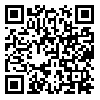1. Branson, William, (2007), Macroeconomic theory and policy, translation Abbas Shakeri, Reed Publishing
2. Debuque-Gonzales, Margarita; Gochoco-Bautista, Maria Socorro. 2013. Financial Conditions Indexes for Asian Economies. © Asian Development Bank. http://hdl.handle.net/11540/2083. License: CC BY 3.0 IGO.
3. Duguay, P. (1994), "Emprical Evidence On The Strength Of The Monetary Transmission Mechanism In Canada: An Aggregate Approach" Journal Ofmonetary Economics, Vol.33 (1), Pp. 39-61. [
DOI:10.1016/0304-3932(94)90013-2]
4. Freedman, C. (1995), "The Role of Monetary Conditions And The Monetary Conditions Index In The Conduct Of Monetary Policy", Bank Of Canada Review, Autumn 1995..
5. Gauthier, C., Graham, C. And Liu, Y. (2004), "Financial Conditions Indexes For Canada",WP 2004-22
6. Gerlach, S. And Smets, F. (2000), "Mcis And Monetary Policy'', European Economic Review, No.44, Pp.1677-1700.
7. Goodhart, C. (2001), "What Weight Should Be Given To Asset Prices In The Measurement Of Inflation?" The Economic Journal, 111, Pp 335-56 [
DOI:10.1111/1468-0297.00634]
8. Goodhart, C. And Hofmann, B. (2003), "Asset Prices, Financial Conditions, And Thetransmission Of Monetary Policy", Paper Presented At The Conference On Asset Prices, Exchange Rates And Monetary Policy, Stanford University, March 2-3, 2001.
9. Hatzius, Jan, Hooper, Peter, . Mishkin. Frederic S, Schoenholtz, , Kermit L, Watson , Mark W. ( 2010), Financial Conditions Indexes: A Fresh Look after the Financial Crisis, NBER Working Paper No. 16150, http://www.nber.org/papers/w16150
10. Hataisereerungsun, 1998. The Roles Of Monetary Conditions And The Monetary Conditions Index In The Conduct Of Monetary Policy: The Case Of Thailand Under The Floating Rate Regime, Bank Of Thailand Quarterly Bulletin
11. Hossain, Akhtar and Anis Chowdhury, (1382). Monetary and financial policies in developing countries, Tehran, Press Institute of Economic Affairs
12. Kamijani, A. (1373) Appropriate Policies To Stabilize Economic Activity, Tehran: Department of Economic Affairs, Ministry of Economic Affairs and Finance
13. Kamijani, A. (1379) Mechanisms for Monetary Transmission Mechanism in the form of an open economy model Proceedings of the Central Bank of Iran, pages 31-82
14. Kamijani, A. Ali Nzhadmhrbany, F. (1391), evaluating the effectiveness of monetary transmission channels on output and inflation and an analysis of their relative importance in the economy, Journal of Year 17, No. 2, 39-64
15. Kirsten Thompson,Reneé Van Eyden,Rangan Gupta.(2013) Identifying A Financial Conditions Index For South Africa, Department Of Economics, University Of Pretoria, Pretoria 0002, South Africa
16. Kesriyeli M., Kocaker I. I., 1999. Monetary Condition Index: A Monetary Policy Indicator For Turkey, Discussion Paper No. 9908, Central Bank Of Republic Of Turkey.
17. Knedlik, Tobias ,2005, Luxembourg, Estimating The Monetary Conditions Index For South Africa
18. Khataee,M and pour Seifi R. (1385). Monetary policy instruments and rules known in Iran's economy, Economic Research Journal, No. 237, page 267-73
19. Khorsandy, M, Eslamloueyan ,K, Zvalnvr, SH (1391), monetary conditions index for the Iranian economy , Journal of Economic Research, , the twelfth year, the first issue ,Spring ,pages 31-57
20. Jamshidi, A., (1381). Monetary policy in Iran, Volume 1, Tehran Iran Industrial Development Investment Company Publishing
21. Lack, C.P. (2003), "A Financial Conditions Index for Switzerland", Monetary Policy in a Changing Environment, BIS Paper No. 19, Bank for International Settlement, Basel, pp. 398-413.
22. Mayes, David, and Matti Virén. 2001. Financial Conditions Indexes. Bank of Finland Discussion Paper No. 2001–17.
23. Mishkin, Frederic, (1998), "The Channels of Monetary Transmission: Lessons for Monetary
24. Policy ," NBER Working Paper No. 5464.
25. Peng W., Leung F., 2005. A Monetary Conditions Index For Mainland China, Hong Kong Monetary Authority Quarterly Bulletin
26. Rahmani, T. (1381). Macroeconomics, vol. 1 and 2, Tehran, brothers Publishing,
27. Renani Sharifi, H., Ghobadi, S., (1391), to investigate the effect of monetary policy on GDP and inflation through housing price index, economic development of programming, first year, first issue, spring and summer 1, 48-69
28. Renani Sharifi, H., Kamijani, Akbar and other cities, H. (1389), Study on Monetary Transmission Mechanism in Iran: A Structural Vector Auto Regressive approach, Journal of Money and the economy, Issue 2, Winter 1388
29. R. Kannan, Siddhartha Sanyal And Binod Bihari Bhoi,( 2006), Reserve Bank Of India Occasional Papers, Monetary Conditions Index For India, Vol. 27,Pp.58-86
30. Sadeghi, Hossein, Rostamzadeh, P and H Asgharpour (1386), separation of monetary policy from the monetary conditions index in Iran, a useful, December, Issue 13: 59-82
31. Shirinbakhsh, Shams Ali and Khansari, Hassan, (1384). Eviews applications in econometrics, Tehran Research Institute of Economic Affairs,
32. Svensson, L. (2000), 'Open-Economy Inflation Targeting',Journal International Economics, 50, Pp 155-183
33. Tashkini, A., (1384). Using econometric microfit, Tehran, Tehran University Publication
34. Vashghani, M. (1390), the monetary transmission mechanism and effectiveness of monetary policy, and economic policy issues, monthly economic magazine, Issue 12, March: 159-166







